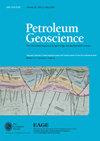Applications of real-time chemical stratigraphy in support of the safe drilling of HPHT wells: examples from the Shearwater Field, Central North Sea, UK
IF 2.1
4区 地球科学
Q3 GEOSCIENCES, MULTIDISCIPLINARY
引用次数: 1
Abstract
X-ray fluorescence (XRF) data from a series of high-pressure–high-temperature (HPHT) wells drilled in the Shearwater Field, UK Continental Shelf (UKCS) are presented. These data comprise a total of 789 samples across a series of eight study wells. Chemical stratigraphy was utilized in conjunction with other geological data (i.e. well logs, ditch cutting descriptions and biostratigraphic analyses) to aid real-time stratigraphic placement. Systematic changes in geochemical composition were identified and used to build a chemostratigraphic zonation to aid delineation of lithostratigraphic boundaries. The application of chemical stratigraphy provided a valuable source of data, particularly through critical ‘drill-in-liner’ sections that are devoid of conventional logging while drilling (LWD) data. The identification of key geochemical zones and provision of a synthetic gamma-ray (Synth GR) profile were utilized in the placement of key casing points and identification of challenging top reservoir picks (Fulmar Formation). These data also served as a backup during LWD tool failure resulting from excessive temperatures. The successive addition of geochemical data accumulated with each well-site exercise permitted continued refinement of the zonation framework, with derived Synth GR profiles exhibiting an extremely close relationship with subsequent wireline logs. Chemical stratigraphic data are shown to be robust and repeatable within the Shearwater Field, enabling close stratigraphic control through critical sections, whilst also providing a low-cost backup in the event of conventional logging tool failures.实时化学地层学在高温高压井安全钻井中的应用:以英国北海中部Shearwater油田为例
介绍了英国大陆架Shearwater油田一系列高压高温(HPHT)井的x射线荧光(XRF)数据。这些数据包括来自8口研究井的789个样本。化学地层学与其他地质数据(如测井、沟槽切割描述和生物地层学分析)结合使用,以帮助实时地层定位。发现了地球化学组成的系统变化,并利用其建立了化学地层学分带,以帮助圈定岩石地层边界。化学地层学的应用提供了宝贵的数据来源,特别是在没有常规随钻测井(LWD)数据的关键“尾管钻进”段。关键地球化学带的识别和合成伽马射线(Synth GR)剖面的提供用于关键套管点的定位和具有挑战性的顶部储层拾取(Fulmar组)的识别。在温度过高导致LWD工具失效时,这些数据也可以作为备份。每一次井场作业中积累的地球化学数据的连续添加,使得分区框架得以持续改进,得到的Synth GR剖面与随后的电缆测井曲线显示出极其密切的关系。在Shearwater油田中,化学地层数据被证明是可靠且可重复的,可以通过关键剖面进行严密的地层控制,同时在常规测井工具失效的情况下提供低成本的备份。
本文章由计算机程序翻译,如有差异,请以英文原文为准。
求助全文
约1分钟内获得全文
求助全文
来源期刊

Petroleum Geoscience
地学-地球科学综合
CiteScore
4.80
自引率
11.80%
发文量
28
审稿时长
>12 weeks
期刊介绍:
Petroleum Geoscience is the international journal of geoenergy and applied earth science, and is co-owned by the Geological Society of London and the European Association of Geoscientists and Engineers (EAGE).
Petroleum Geoscience transcends disciplinary boundaries and publishes a balanced mix of articles covering exploration, exploitation, appraisal, development and enhancement of sub-surface hydrocarbon resources and carbon repositories. The integration of disciplines in an applied context, whether for fluid production, carbon storage or related geoenergy applications, is a particular strength of the journal. Articles on enhancing exploration efficiency, lowering technological and environmental risk, and improving hydrocarbon recovery communicate the latest developments in sub-surface geoscience to a wide readership.
Petroleum Geoscience provides a multidisciplinary forum for those engaged in the science and technology of the rock-related sub-surface disciplines. The journal reaches some 8000 individual subscribers, and a further 1100 institutional subscriptions provide global access to readers including geologists, geophysicists, petroleum and reservoir engineers, petrophysicists and geochemists in both academia and industry. The journal aims to share knowledge of reservoir geoscience and to reflect the international nature of its development.
 求助内容:
求助内容: 应助结果提醒方式:
应助结果提醒方式:


